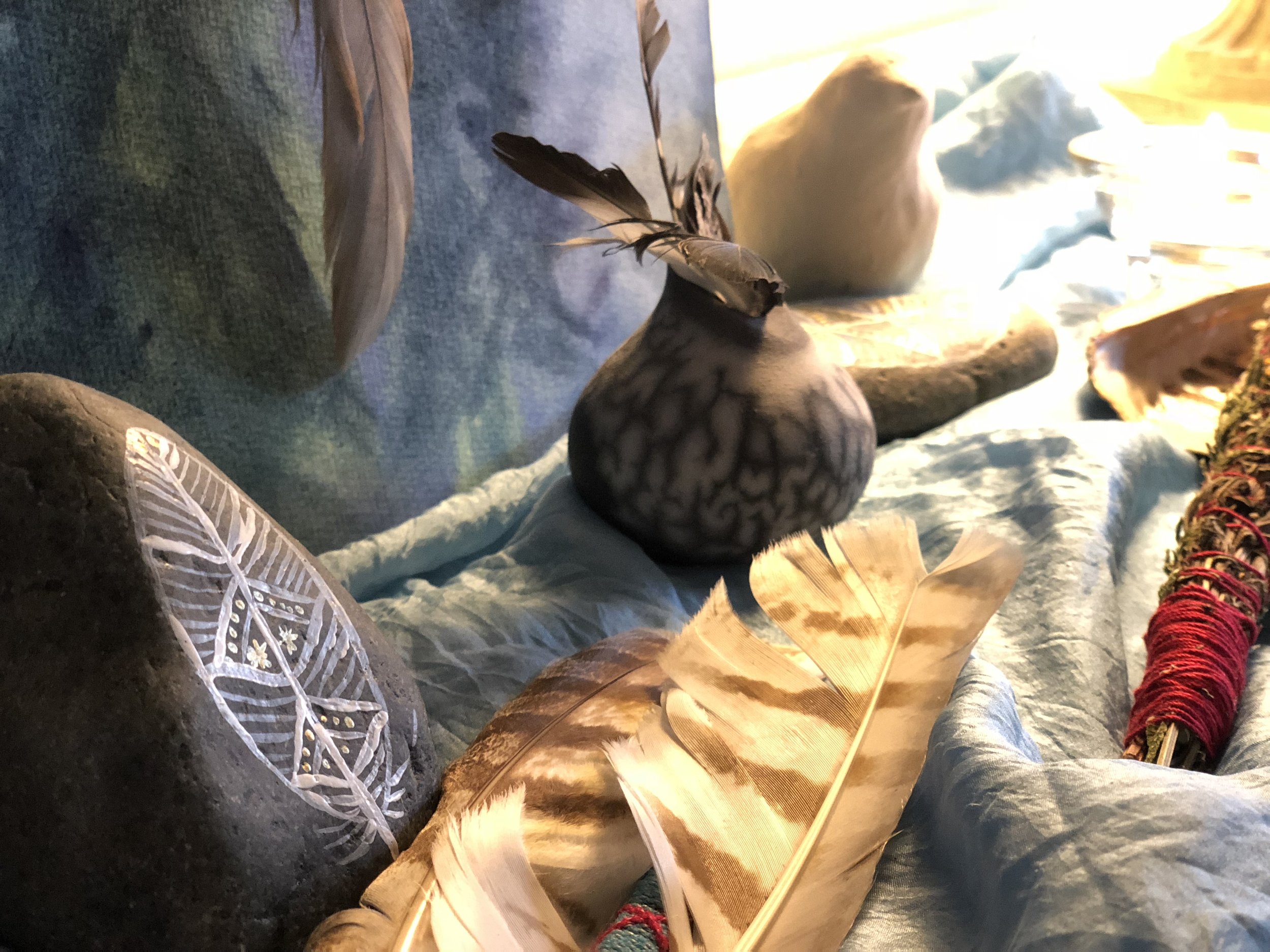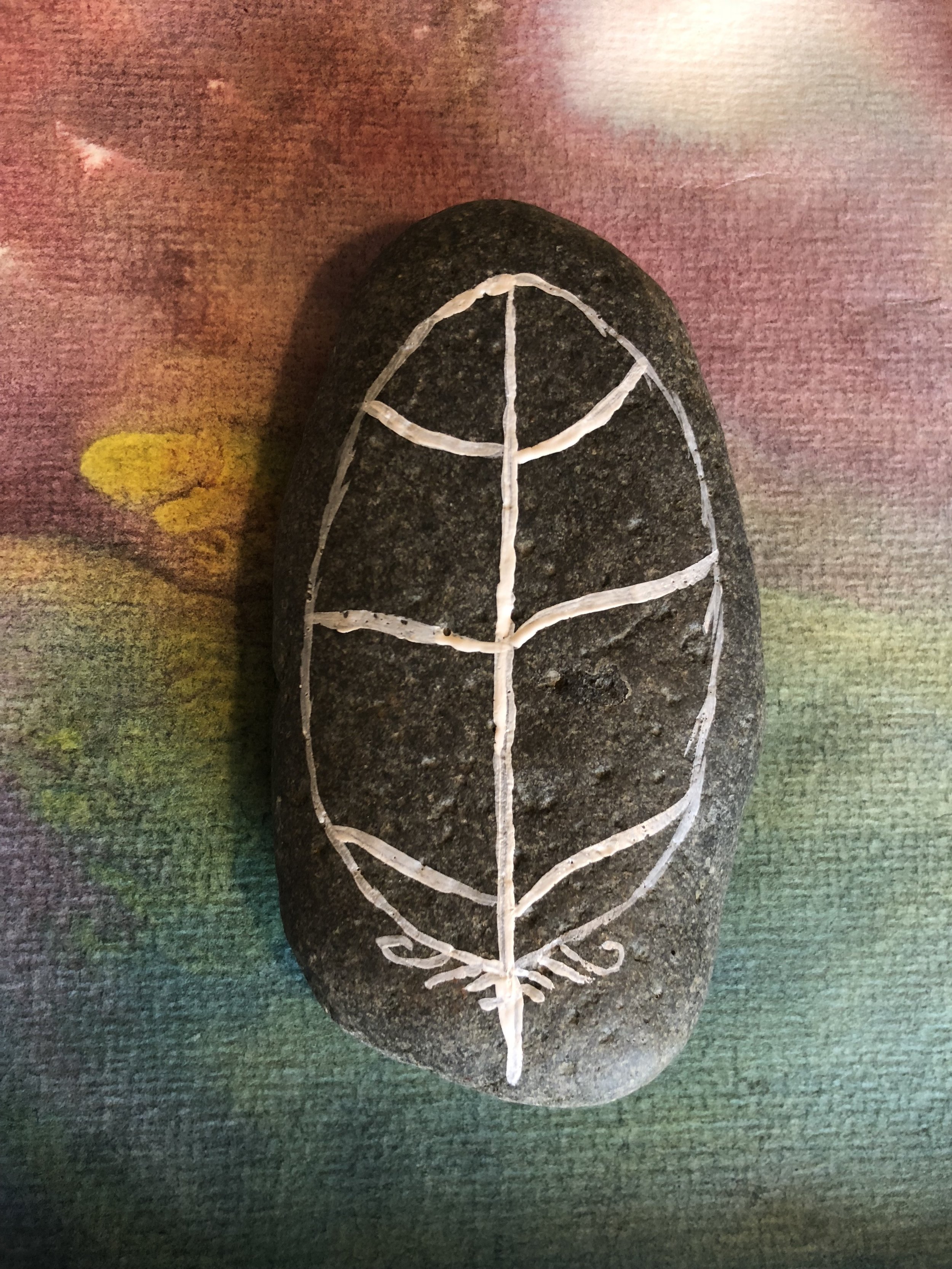God on a Wing: Winter Rewilding Nature Altar
/Our family keeps a nature altar, a way to not only bring the out-doors in, but to also attune our senses to the phases of the seasons, the beauty of the natural world, and as a portal to the deep wisdom that resides in the wild. This sacred space has taken up various iterations in the years we have done this practice. When the household was generally filled with very little people, these silks were piled high with sticks and stones; every item outside was a treasure and little hands begged that every one was brought indoors. To an uneducated heart, this space would have looked like a random pile of rocks, but to us it was our Ebenezer. Our collection of nature was our stone of help—a waymarker that provided direction and clarity to our sacred belonging to and with the Earth community. This pile dynamically grew through the year, representing so many different journeys and encounters with awe and wonder.
Now that half of my children have their toes in teen-hood, this space is taking up more thoughtfulness and creativity. Furthermore, we are using this altar to mark our seasonal journey through the Rewilding Wheel. This has given a bit more focus and direction, and invites our family to pay attention to particular theophanies (God-showings) within the natural world.
The Rewilding Wheel is a sacred circuit that seeks to locate the wisdom of universal nature symbols with one’s particular homescape and spiritual formation. By locating the psychospiritual patterns found within the natural world to a particular place, the ancient wisdom inherent in the cardinal directions and elements takes on a practical shape and invites a focused seasonal practice. In this way, the Rewilding Wheel is unique as it invites a sacred process of remembering and recovering relationships within various ecosystems throughout your bioregion. This is a practice of sacred bioregionalism—where the particularity of our place educates our soul and brings us closer to Spirit that resides there as well.
The Rewilding Wheel was developed to be an integration of critical aspects of the cycles and seasons of nature that would bring one into a deep sense of belonging within their particular bio-regions. This is a move from an ego-centric posture on the planet to an eco-centric one where one’s whole identity is rooted and interconnected with all of creation. This posture requires sensory participation and deep paying attention to the phenomena that is going on about one in their surrounding landscapes.
“To be rooted is perhaps the most important and least recognized need of the human soul.”
-Simone Weil
For those of you practicing this sacred circuit, we know that the season of Winter is associated with the cardinal direction of North, the element of Air, and the bioregion of the Mountain or High Place. This is a time of deep darkness that is held in tension with the lightness of breath, bound to the found-wisdom that is associated with mountain tops and high places. A symbol for this season is that of the bird, a being who rides the wind currents and alights in high places with ease. This is the season of the work of the Spirit, who breathes inspiration and insight into our souls.
This wheel invites seeing the Sacred with sensuality, an embodiment through the elements that gives form and shape to that which has been traditionally transcendent. The Spirit is air. The Judaeo Christian cosmology tells a story of when God breathes air into the lungs of the first human being (“then the Lord God formed adam from the dust of the ground, and breathed into his nostrils the breath of life, and adam became a living being”; Genesis 2:7). The Hebrew word for this primordial breath of life (ruach, or pneuma in Greek) also means Spirit. God’s Spirit is God’s breath, signaling the sub stratosphere itself. All that we and all other beings need for survival, is the animating power of the Sacred in our midst—God swirling and whirling around us, making all things live. The research and study of ecotheologian Mark Wallace in his book When God Was a Bird: Christianity, Animism, and the Re-Enchantment of the World (2018) looks at how the Spirit is generally figured as a winged animal, a bird. His claim is that within this tradition is an animistic understanding of God, that the divine actually is visible, enfleshed, incarnate even through the more-than-human world. This idea of a winged bird God is something I am meditating on and allowing to work on me in this Winter season. Pair this holy avian form with the mystery of the mountains during these dark and dormant months, and my goodness! There is a treasure trove of wisdom into which to huddle.
We have been putting together our Winter Nature Altar slowly following Epiphany last week and the closing of the Christmas season. Guiding this practice are the thematic elements found within the Rewilding Wheel. We have all been making these stone feathers—what a fun way to play with the form of mountain and air!—and wanted to share this seasonal altar craft with you.
I’m grateful to the artist Marisa Redondo for this inspiration within the pages of Nature Art Workshop (Quarto Publishing Group, 2018). This was the seasonal wild-craft offered to registrants of the Winter Rewilding Retreat as well. Such beautiful stone feathers were created!
This simple stone design reminds us of the primordial presence of the mountains and high places in our bioregion, and how this location is often associated with wise-people and sages. Pairing it with the intricate beauty of the feather is a mediation on God as a feathered bird and the belief that all beings, including more-than-human animals, are imbued with divine presence.
Feather Stones
1. Go outside and find a rock that seems to speak to you. Ask the rock permission to take it home. This is a great reason to intentionally go out to the mountains or local high place to find a rock or stone!
2. Gather your materials: stones, craft paints, matte varnish, paint brushes and paint pallet. We chose white, light blue, light green and a gorgeous gold (a precious element found deep within mountains!) for our paints and love the use of wax paper for our palette. While you work, listen for birdsong outside your window, or the sound of the wind in the trees. See this as a sacred presence around you while you create this item for your seasonal altar.
3. Apply a thin and even layer of varnish to your rock. Once dry, paint a thin line centered on your rock with a small round paintbrush.
4. Paint a feather tuft outline around the centerline.
5. Paint V-shaped lines to divide the feather into sections.
6. Fill the tip of your feather with fine lines.
7. Create a triangular shape within the feather by painting two lines in each section.
8. Fill the area outside the triangles with fine, feather-like lines.
9. Add dots or embellishments along triangular border.
White-Eyes
BY MARY OLIVER
In winter
all the singing is in
the tops of the trees
where the wind-bird
with its white eyes
shoves and pushes
among the branches.
Like any of us
he wants to go to sleep,
but he's restless—
he has an idea,
and slowly it unfolds
from under his beating wings
as long as he stays awake.
But his big, round music, after all,
is too breathy to last.
So, it's over.
In the pine-crown
he makes his nest,
he's done all he can.
I don't know the name of this bird,
I only imagine his glittering beak
tucked in a white wing
while the clouds—
which he has summoned
from the north—
which he has taught
to be mild, and silent—
thicken, and begin to fall
into the world below
like stars, or the feathers
of some unimaginable bird
that loves us,
that is asleep now, and silent—
that has turned itself
into snow.



















